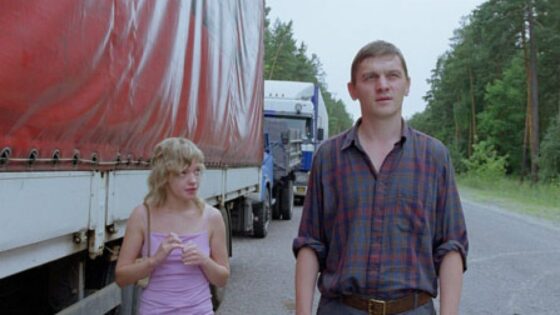Best of the Decade: Sergei Loznitsa

By Atom Egoyan
I first encountered Sergei Loznitsa’s work at the Cannes Film Festival in 2010. Though I was busy watching student films and shorts as president of the Cinefondation jury, I found some time to steal away and watch some other work in the Official Selection. Loznitsa’s feature My Joy was in Competition.
Watching this film changed something about what my sense of cinema could be. It presented itself as a realist film about a trucker named Georgy, but something shifts in his journey when he picks up a child prostitute along the way. Traffic comes to a stop on the highway, so she suggests an alternate route. After stopping at a village along this rough road, the child prostitute starts to scream at Georgy for his hypocritical sense of charity and leaves him. At this point the camera recording the action becomes unmoored from its passive role as observer.
As the camera begins to drift through a large group of villagers, it is uncertain whose point of view the viewer is witnessing as the peasants’ faces are observed. At first it seems to be Georgy’s, but then it slips into something else. It is as if the viewer has suddenly been displaced from the narrative and has become a part of the collective consciousness of the people in this town. The gaze has been transformed from the structured following of a plotted story and has now taken the viewer somewhere unexpected and completely absorbing. Wherever the viewer now found themselves, a different world has been entered and the transition has been both seamless and imbued with extraordinary power.
I met Loznitsa at a festival in Armenia a couple of months later, and we spent a long night talking about My Joy. At the time, I was president of the Golden Apricot International Film Festival, though I had no role in the film winning the Silver Apricot Special Prize a few nights later.
Loznitsa offered to bring a collection of his DVDs when he came to the Toronto International Film Festival that September. I remember being so excited to see these other films when he handed me the promised package that I missed a couple of TIFF screenings. His earlier work, including a stunning dramatic hour called Landscape (2003), more than lived up to the high expectations his first feature had generated. It also included early experiments in repurposing historical footage in films such as Blockade (2006) and Landscape.
What excites me about his films is that they refuse to follow traditional rules. They are absolutely riveting yet at times quite inert, bucking convention while embracing it at times with absurd and totalitarian conviction. Maidan (2014) records the Peoples’ Revolution in the Ukraine (years before the one in Armenia) with an astonishing eye to the human scale that nurtured this democratic impulse. It is a masterful representation of the crowd in history.
State Funeral (2019), his most recent work, is about another crowd in history. At first, the film seems to amplify all of the intentions of the bloated four-day event that surrounded Stalin’s funeral. Hundreds of cameramen spread throughout the Soviet Union recorded the nation’s bleeding and terrified heart. Loznitsa extends this process by reverentially restoring lost footage and adding sumptuously recorded sound foley that heightens every moment. But to what end? Why are we watching this?
There are so many things to meditate upon while witnessing this epic flow of imagery. Loznitsa’s brilliant decision to break continuity by repeating the same action as it was recorded by different cameras almost goes unnoticed because of the sheer monumental flow of the event. Time is both heavily manipulated yet seemingly uninterrupted. There is no such thing as “fake news” in a world where the cult of personality, celebrated in such an authentically staged spectacle, overwhelms any delineation between reality and illusion. Triumph of the Will as World and Representation.
Loznitsa’s films are not flawless. But I’m not expecting perfection from an artist who creates such strange and perverse concoctions that seem almost designed to falter at some level. This is part of the fascination. Utterly convincing dramatic propositions suddenly go strangely wrong, like at the end of A Gentle Creature (2017). We think we’re seeing one type of film, then we’re seeing another. It’s messy, and I like that.
Loznitsa’s cinema is authentic, but never precisely determined as to what it purports to show. Things may have been happening in a way that no one could have possibly understood at the moment they were recorded, by the time they have been watched, and by the way they might be remembered. What’s always remarkable about Loznitsa’s work is his intensity and depth of scrutiny. I believe that he is one of the few filmmakers who have their regard as intensely focused on the past as the present. I look forward to his future.
Atom Egoyan- « Previous
- 1
- 2


